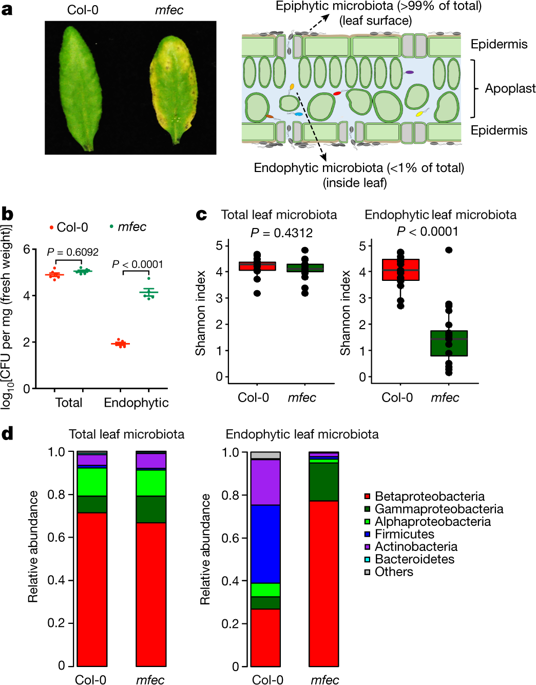Nature ( IF 64.8 ) Pub Date : 2020-04-08 , DOI: 10.1038/s41586-020-2185-0 Tao Chen 1, 2, 3 , Kinya Nomura 1 , Xiaolin Wang 4 , Reza Sohrabi 1, 5 , Jin Xu 6 , Lingya Yao 4 , Bradley C Paasch 1 , Li Ma 1 , James Kremer 1 , Yuti Cheng 1, 3 , Li Zhang 1, 3 , Nian Wang 6 , Ertao Wang 4 , Xiu-Fang Xin 4, 7 , Sheng Yang He 1, 3, 5

|
The aboveground parts of terrestrial plants, collectively called the phyllosphere, have a key role in the global balance of atmospheric carbon dioxide and oxygen. The phyllosphere represents one of the most abundant habitats for microbiota colonization. Whether and how plants control phyllosphere microbiota to ensure plant health is not well understood. Here we show that the Arabidopsis quadruple mutant (min7 fls2 efr cerk1; hereafter, mfec)1, simultaneously defective in pattern-triggered immunity and the MIN7 vesicle-trafficking pathway, or a constitutively activated cell death1 (cad1) mutant, carrying a S205F mutation in a membrane-attack-complex/perforin (MACPF)-domain protein, harbour altered endophytic phyllosphere microbiota and display leaf-tissue damage associated with dysbiosis. The Shannon diversity index and the relative abundance of Firmicutes were markedly reduced, whereas Proteobacteria were enriched in the mfec and cad1S205F mutants, bearing cross-kingdom resemblance to some aspects of the dysbiosis that occurs in human inflammatory bowel disease. Bacterial community transplantation experiments demonstrated a causal role of a properly assembled leaf bacterial community in phyllosphere health. Pattern-triggered immune signalling, MIN7 and CAD1 are found in major land plant lineages and are probably key components of a genetic network through which terrestrial plants control the level and nurture the diversity of endophytic phyllosphere microbiota for survival and health in a microorganism-rich environment.
中文翻译:

防止植物圈生态失调的植物遗传网络
陆生植物的地上部分统称为植物圈,在大气中二氧化碳和氧气的全球平衡中起着关键作用。植物圈是微生物群定植最丰富的栖息地之一。植物是否以及如何控制叶际微生物群以确保植物健康尚不清楚。在这里,我们展示了拟南芥四重突变体 ( min7 fls2 efr cerk1;此后称为mfec ) 1,同时存在模式触发免疫和 MIN7 囊泡运输途径缺陷,或组成型激活的细胞死亡 1 ( cad1) 突变体,在膜攻击复合物/穿孔素 (MACPF) 结构域蛋白中携带 S205F 突变,具有改变的内生叶际微生物群并显示与生态失调相关的叶组织损伤。香农多样性指数和厚壁菌门的相对丰度显着降低,而变形杆菌在mfec和cad1 S205F中富集突变体,与人类炎症性肠病中发生的生态失调的某些方面具有跨界相似性。细菌群落移植实验证明了正确组装的叶片细菌群落在植物圈健康中的因果作用。模式触发的免疫信号,MIN7 和 CAD1 存在于主要的陆生植物谱系中,可能是遗传网络的关键组成部分,陆生植物通过该网络控制内生叶际微生物群的水平并培育其多样性,以便在富含微生物的环境中生存和健康.


























 京公网安备 11010802027423号
京公网安备 11010802027423号